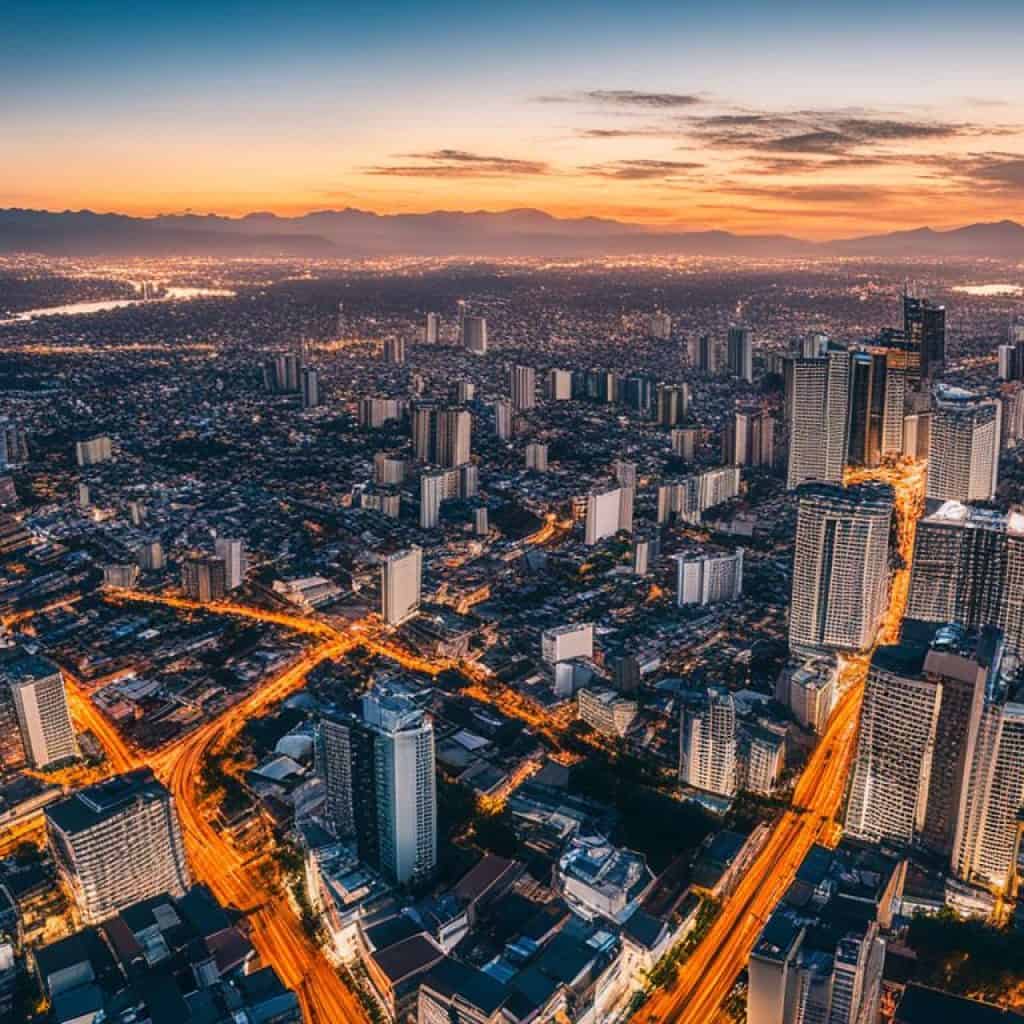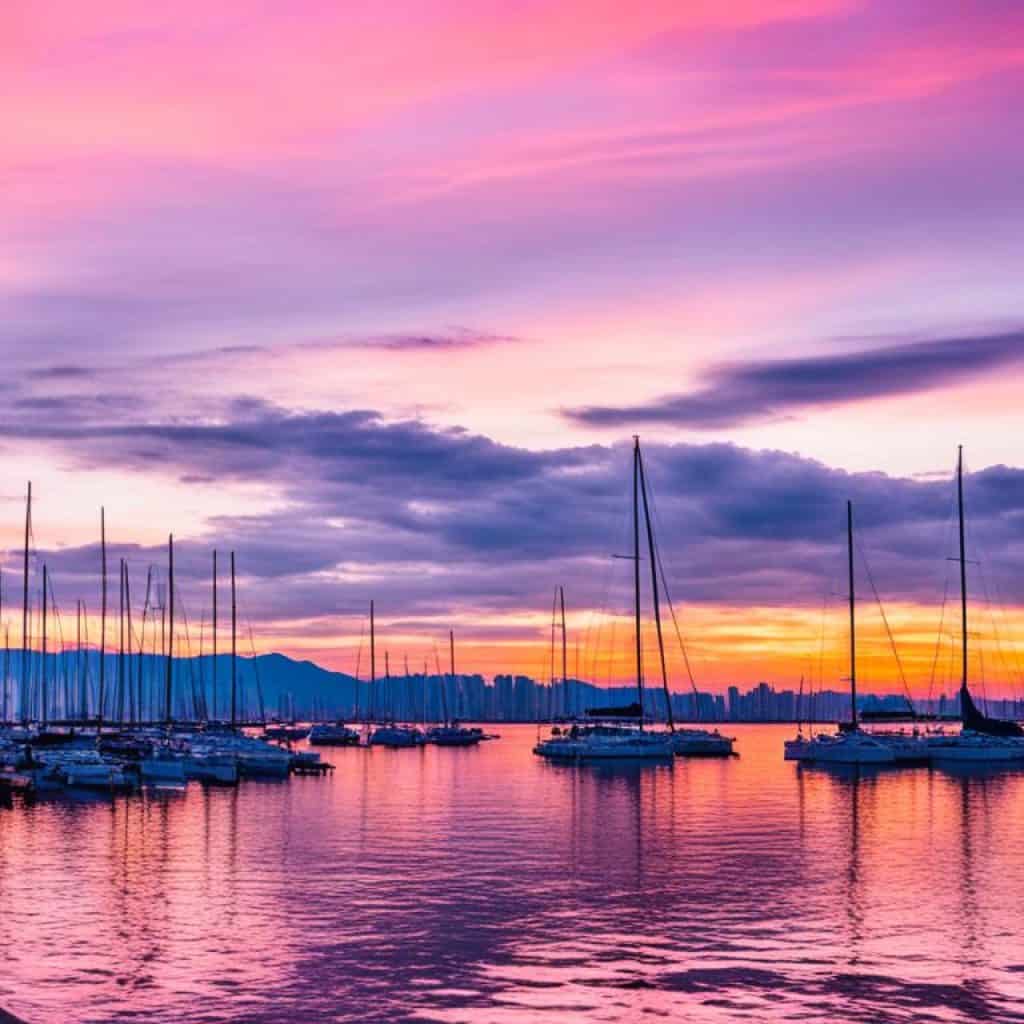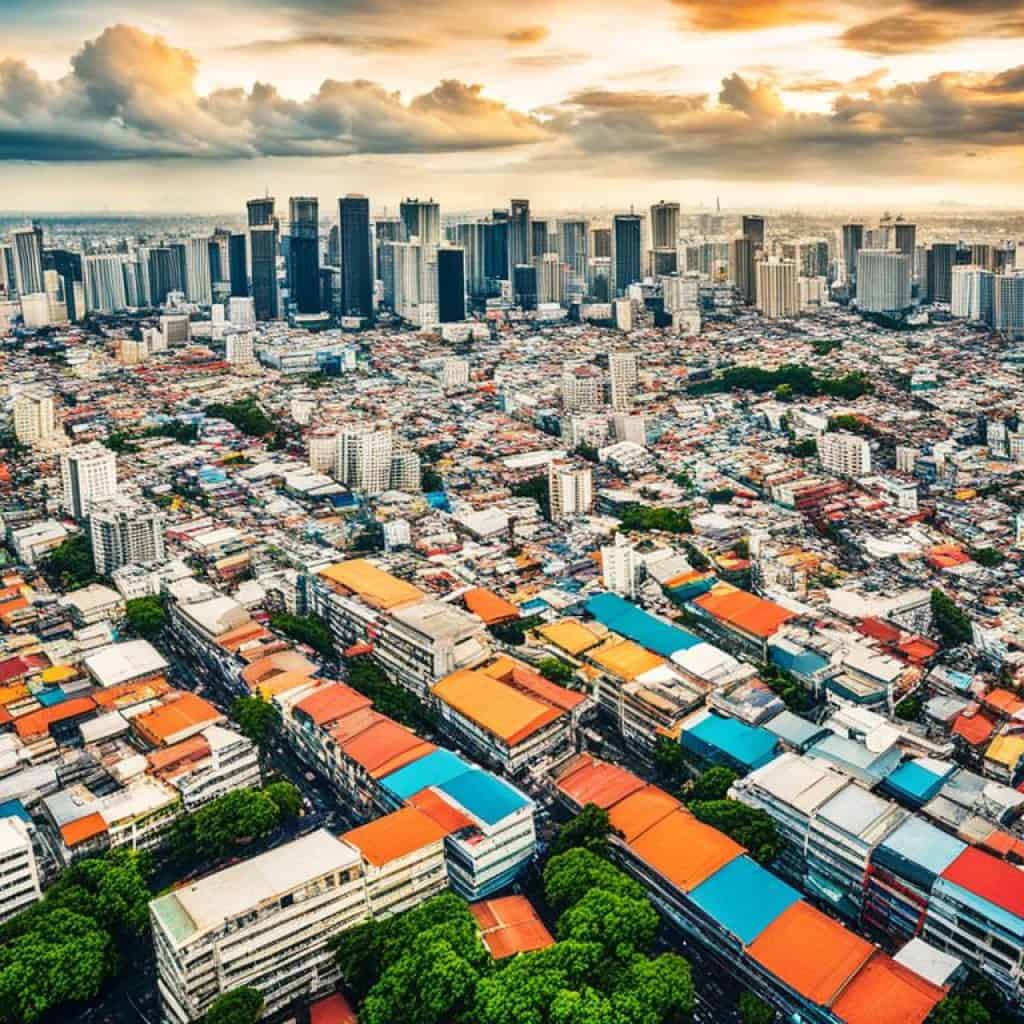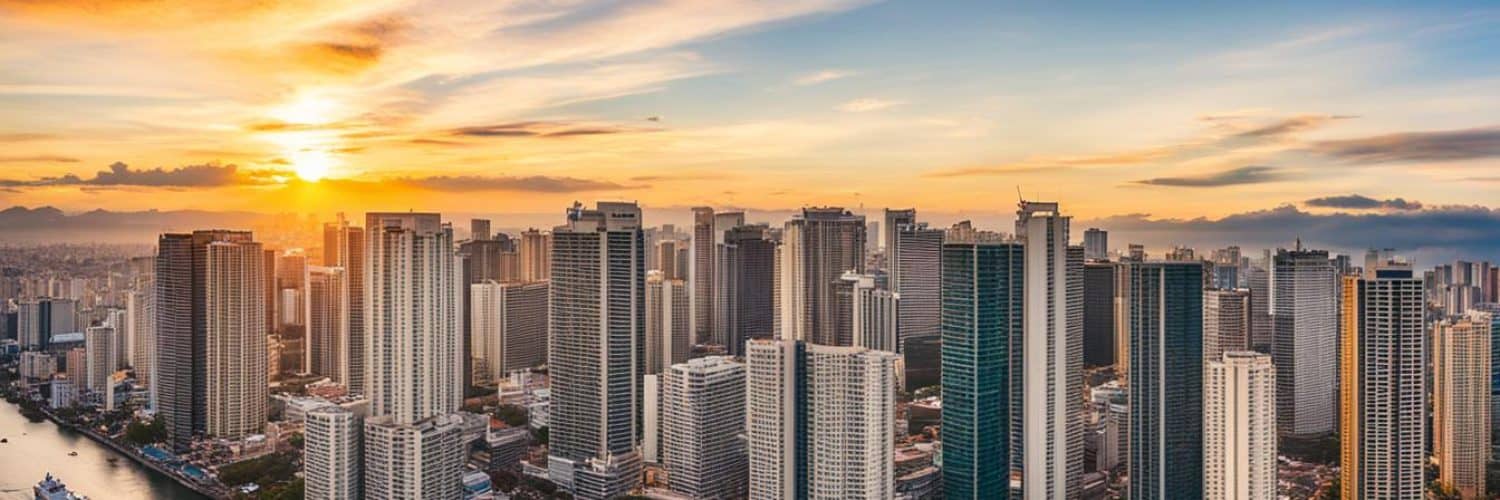What is the capital of the Philippines? If you think you know the answer, think again. The capital city of the Philippines is not only a bustling metropolis but also a hub of economic, political, social, and cultural activity. This city has a rich history, diverse population, and vibrant energy that make it a must-visit destination. So, are you ready to uncover the secrets of the Philippines’ capital? Let’s dive in!
Key Takeaways:
- Manila is the capital and chief city of the Philippines, known for its economic, political, social, and cultural significance.
- The city’s name, Manila, is derived from the nilad plant, which once grew abundantly along the Pasig River.
- Manila has been the principal city of the Philippines for centuries and is an important international port of entry.
- Explore Manila’s rich history, diverse cultural heritage, and vibrant energy that make it a unique destination.
- Uncover the hidden treasures of Manila, from iconic landmarks to dynamic districts and everything in between.
A Dynamic Center of Culture and History
Manila, the capital of the Philippines, is a city steeped in culture and history. It has been a hub of trade and commerce for centuries and is rich in historical landmarks and cultural sites that showcase its diverse heritage. One of the most iconic attractions in Manila is the historic walled city of Intramuros, a UNESCO World Heritage site that dates back to the Spanish colonial period. Here, visitors can explore well-preserved churches, forts, and museums that offer a glimpse into Manila’s past.
The arts and music scene in Manila is vibrant and lively. The city is home to numerous theaters, art galleries, and music venues that cater to a wide range of artistic interests. Whether you’re a fan of classical music, contemporary art, or traditional Filipino performances, Manila has something to offer. The Cultural Center of the Philippines, located in Manila, is a prime destination for those seeking a taste of the local arts scene.
“Manila is a city that celebrates its cultural diversity and embraces its history. It’s a place where traditions and modern influences merge, creating a unique and dynamic atmosphere.”
Manila’s cosmopolitan nature is evident in its culinary scene. The city is known for its diverse food offerings, ranging from traditional Filipino delicacies to international cuisines. Visitors can indulge in a gastronomic adventure, exploring the city’s numerous markets, restaurants, and street food stalls. The combination of flavors and culinary techniques reflects the multicultural makeup of Manila.
Historical Landmarks in Manila
When visiting Manila, be sure to explore the following historical landmarks:
- Intramuros: The historic walled city showcases Spanish colonial architecture and houses significant sites, including Fort Santiago and San Agustin Church.
- Rizal Park: This expansive park pays tribute to the Philippines’ national hero, Dr. Jose Rizal, and features monuments, gardens, and a grandstand.
- Bahay Tsinoy: This museum celebrates the Filipino-Chinese heritage and showcases the contributions of the Chinese community to Philippine history and culture.
- National Museum of the Philippines: With a broad collection of Filipino art and artifacts, this museum offers an in-depth exploration of the country’s cultural heritage.
Experience the dynamic blend of culture and history in Manila, the Filipino capital. Immerse yourself in the vibrant arts scene, marvel at historical landmarks, and indulge in the diverse culinary offerings. Manila is a city that embraces its past while continuously evolving and embracing new influences.
Location and Geography
Manila is situated on the eastern shore of Manila Bay, at the mouth of the Pasig River, and is a part of the larger metropolitan region known as Metro Manila or the National Capital Region (NCR) in the Philippines. The city’s strategic location has made it a prominent center for trade and commerce in the region.
The geography of Manila is characterized by a low, narrow deltaic plain, bordered by the Sierra Madre mountains to the east and Manila Bay to the west. This unique location provides the city with beautiful natural landscapes and scenic views.

The National Capital Region encompasses several cities and municipalities, including Manila, and serves as the economic, political, and cultural hub of the Philippines. The region’s proximity to major transportation routes and ports has further enhanced its importance as a center for trade and development.
As a coastal city, Manila benefits from its access to the bay, offering opportunities for maritime activities and waterfront development. Furthermore, its location along the Pasig River provides a vital waterway that connects the city to other parts of the country.
The diverse geographical features of Manila, from mountains to bay areas, provide a rich tapestry of natural beauty that complements the vibrant urban environment.
“Manila’s strategic location and unique geography make it a prime center for trade, commerce, and urban development in the Philippines.”
Climate and Weather
Manila, the vibrant capital of the Philippines, experiences a tropical climate with distinct wet and dry seasons. Understanding the climate and weather patterns of Manila is essential for planning your visit and ensuring a comfortable stay.
The Wet Season: June to November
During the wet season, which extends from June to November, Manila receives the majority of its rainfall. The wettest months are July, August, and September, when thunderstorms are common and heavy downpours are a regular occurrence. With an average annual rainfall of about 80 inches (2,000 mm), this period is characterized by lush greenery and vibrant vegetation.
The Dry Season: December to May
From December to May, Manila experiences a dry season with little to no rainfall. This period is marked by sunny weather, lower humidity levels, and pleasant temperatures. Average temperatures in Manila remain relatively constant throughout the year, with the thermometer hovering around the low 80s F (about 27 °C).
Whether you prefer the lush greenery of the wet season or the sunny days of the dry season, Manila offers a diverse range of experiences throughout the year.
| Season | Precipitation | Temperature |
|---|---|---|
| Wet Season | High precipitation | Approximately low 80s F (about 27 °C) |
| Dry Season | Low precipitation | Approximately low 80s F (about 27 °C) |
Landscapes and Natural Beauty
Manila, the capital of the Philippines, is blessed with stunning landscapes and natural beauty that make it a truly remarkable destination. The city is situated on a low, narrow deltaic plain along the banks of the picturesque Pasig River, which adds to its charm and allure.
“Manila is a city that seamlessly blends urban development with natural landscapes.”
To the west of Manila lies Manila Bay, renowned for its breathtaking sunset views and as one of the finest sheltered harbors in the Pacific region. The panoramic vistas of Manila Bay attract locals and tourists alike, offering a tranquil escape from the bustling city life.

The southeast of Manila is adorned with the majestic Laguna de Bay, a vast lake from which the Pasig River flows. The lake is not only a source of scenic beauty but also plays a crucial role in the city’s water supply and flood prevention measures.
Natural Wonders Surrounding Manila
| Location | Description |
|---|---|
| Bataan Peninsula | Located to the west of Manila Bay, the Bataan Peninsula offers stunning natural landscapes, including beautiful beaches and lush forests. It is a popular destination for outdoor activities such as hiking, bird watching, and water sports. |
| Laguna de Bay | This large lake is the largest in the Philippines and provides a serene respite from the city’s hustle and bustle. Visitors can enjoy boating, fishing, and picnicking by the lake’s tranquil shores. |
| Sierra Madre Mountains | Stretching along the eastern coast of Luzon, the Sierra Madre mountains offer breathtaking views and opportunities for exploration and adventure. The rugged terrain and dense forests make it a haven for nature enthusiasts and thrill-seekers. |
Manila’s landscapes and natural wonders add to the city’s allure, offering a harmonious balance between urban development and the preservation of its natural heritage. Visitors to Manila can immerse themselves in the city’s vibrant cultural scene while taking time to appreciate the breathtaking beauty that surrounds them.
Flora and Fauna
Manila, the capital of the Philippines, boasts a rich variety of plant and animal life. The city is adorned with lush tropical trees, including graceful palms, majestic banyans, and beautiful acacias that offer shade and beauty to its streets. Bamboo can also be found in public parks, adding to the natural charm of the city.
The diverse wildlife of Manila includes domestic mammals like water buffalo, horses, dogs, pigs, and goats, which are commonly seen in the city’s neighborhoods and rural areas. These animals contribute to the cultural fabric of the city and serve as a reminder of its rural roots.
However, it is the marine life of Manila Bay that truly captivates nature enthusiasts. Manila Bay is teeming with a vibrant ecosystem of marine species. Sardines, anchovies, mackerel, tuna, snappers, and barracuda thrive in its waters, creating a spectacle of underwater beauty. These marine creatures form an essential part of Manila’s ecosystem, with their presence contributing to the overall balance and biodiversity of the bay.
Unfortunately, the natural beauty of Manila’s flora and fauna is under threat due to pollution and environmental degradation caused by rapid urbanization and industrialization. Efforts must be made to protect and preserve these precious natural resources for future generations to enjoy.
City Layout and Districts
Manila, the capital city of the Philippines, is divided into six administrative divisions, each comprising multiple districts. These districts are the result of the city’s rich history and have developed from the historic walled city of Intramuros and the surrounding villages.
The Pasig River, which bisects the city, serves as a natural boundary. Two-thirds of the districts are located to the north of the river, while the remaining third is situated to the south. The districts along the bay and the city’s west-central region are the main centers of trade and commerce.
Prominent landmarks and institutions are found in different districts, showcasing the diverse character of Manila. For example, in the San Miguel district, you can find the iconic Malacañang Palace, the official residence and workplace of the President of the Philippines. Sampaloc district is home to several esteemed universities, contributing to Manila’s vibrant academic atmosphere.
Key Districts in Manila
| District | Key Landmarks |
|---|---|
| Intramuros | Fort Santiago, San Agustin Church, Manila Cathedral |
| Ermita | Rizal Park, National Museum of Fine Arts |
| Malate | Manila Baywalk, Manila Ocean Park |
| Binondo | Binondo Church, Chinatown |
| Makati | Makati Central Business District, Ayala Museum |
| Quezon City | Quezon Memorial Circle, University of the Philippines Diliman |
These districts offer their own unique charm and contribute to the diverse landscape and culture of Manila. Exploring each district provides a deeper understanding of the city’s history, architecture, and vibrant atmosphere.

Whether you’re strolling through the historic streets of Intramuros, enjoying the scenic Manila Baywalk, or immersing yourself in the bustling atmosphere of Binondo’s Chinatown, Manila’s districts beckon with a multitude of experiences.
Metropolitan Manila and Surrounding Cities
Metropolitan Manila, also known as Metro Manila or the National Capital Region, encompasses the city of Manila along with its neighboring cities and municipalities. This larger metropolitan area is a bustling hub of activity and serves as the economic, political, and cultural center of the Philippines.
One of the prominent cities within Metropolitan Manila is Quezon City. Originally intended to be the capital city of the Philippines, it is now known as the country’s most populous city. Quezon City boasts a vibrant entertainment and dining scene, with numerous shopping malls, restaurants, and bars. It is also home to several government offices and educational institutions.
Another important city in Metropolitan Manila is Caloocan City. It is the third most populous city in the Philippines and offers a mix of residential, commercial, and industrial areas. Caloocan City is known for its cultural heritage, hosting a number of historical landmarks and museums that showcase the city’s history and traditions.
Pasay City is another significant city within Metropolitan Manila, and it is strategically located near Manila Bay. This city is known for its entertainment complexes, luxury hotels, and large shopping centers. Pasay City is also home to the Ninoy Aquino International Airport, the Philippines’ primary gateway for international air travel.
Metropolitan Manila and Surrounding Cities
| City | Area | Population |
|---|---|---|
| Quezon City | 166.20 km² | 2,936,116 |
| Caloocan City | 55.88 km² | 1,583,978 |
| Pasay City | 18.64 km² | 416,522 |
These cities, along with the other municipalities within Metropolitan Manila, work together to provide integrated services and coordinated development for the region. With numerous government offices, commercial centers, and residential areas, Metropolitan Manila is a vibrant and dynamic metropolitan area that contributes significantly to the growth and progress of the Philippines.
Housing and Architecture
Manila faces a chronic housing shortage, with many residents in need of affordable and adequate housing options. To address this issue, the government has implemented tenement housing projects aimed at providing housing for the poor.
The architecture in Manila is a reflection of its diverse cultural influences. The city’s buildings showcase a blend of American, Spanish, Chinese, and Malay architectural styles, resulting in a unique and vibrant urban landscape.
Architectural Landmarks
Manila is home to several notable architectural landmarks that highlight its rich history and cultural heritage. The historic churches of Intramuros, such as the San Agustin Church and Manila Cathedral, are prime examples of Spanish colonial architecture.
“The architectural landmarks of Manila are a testament to the city’s rich history and cultural heritage. They serve as a reminder of the various influences that have shaped the city’s architectural landscape.”
Alongside these historic buildings, modern structures made of reinforced concrete and hollow cement blocks can be found throughout the city. These buildings showcase contemporary architectural designs and contribute to Manila’s urban development.
Burnham Plan of Manila
In the early 20th century, renowned urban planner Daniel Burnham created the Burnham Plan of Manila. The plan aimed to transform and modernize the city by incorporating parks, parkways, and waterfront areas, providing a more cohesive and aesthetically pleasing urban environment.
“The Burnham Plan of Manila aimed to create a unified and beautiful city, showcasing the potential for urban planning to shape and enhance the lives of its residents.”
The Burnham Plan of Manila had a significant impact on the city’s growth and development, shaping the layout and design of various districts and contributing to Manila’s overall urbanization.
| Architectural Styles | Architectural Landmarks |
|---|---|
| American | Intramuros |
| Spanish | San Agustin Church |
| Chinese | Binondo Church |
| Malay | Malate Church |
| Modern | Manila City Hall |
“The architectural styles present in Manila range from American and Spanish influences to Chinese and Malay designs, creating a diverse and visually captivating cityscape.”
The table above highlights different architectural styles found in Manila and notable landmarks associated with each style.
Politics and Government
The politics of the Philippines are characterized by a unitary republic form of government, with the President serving as the head of state and government. Currently, the President of the Philippines is Ferdinand (“Bongbong”) Marcos, Jr., who leads the country’s executive branch.
The Philippines has a bicameral legislature, consisting of the Senate and the House of Representatives, which help in the formulation and enactment of laws. This system ensures a checks-and-balances mechanism within the government.
The country is divided into various administrative divisions, including regions, provinces, cities, municipalities, and barangays (villages). These divisions provide a framework for effective governance and local representation.
The Philippines has a vibrant political landscape with multiple political parties that represent diverse ideologies and interests. Regular elections are held, allowing the citizens to participate in the democratic process and choose their representatives.
The President of the Philippines
“The office of the President is regarded with utmost respect in the Philippines. The President is responsible for leading the country, executing its laws, and ensuring the welfare of its citizens.”
Legislative Structure
| Legislative Body | Role and Responsibilities |
|---|---|
| Senate | The Senate represents the national interest and serves as a platform for national debates and discourse. It plays a crucial role in the passage of bills and the approval of treaties and international agreements. |
| House of Representatives | The House of Representatives represents the various districts and sectors across the country. Its members advocate for local issues and collaborate with senators to craft legislation that addresses the needs of their respective constituencies. |
Administrative Divisions
The administrative divisions of the Philippines are essential for effective governance and local representation. Let’s take a look at the different administrative divisions:
- Regions: The Philippines is divided into 17 regions, each headed by a Regional Governor, to ensure regional development and coordination.
- Provinces: There are 81 provinces in the Philippines, each governed by a Governor, responsible for local administration and implementation of national policies.
- Cities: The country comprises numerous cities, each with its own local government headed by a City Mayor. Cities are centers of trade, commerce, and urban development.
- Municipalities: Municipalities are smaller administrative divisions within provinces, with elected Mayors overseeing local governance.
- Barangays: Barangays are the smallest administrative divisions and serve as the basic political units in the Philippines. Each barangay is led by a Barangay Captain who represents the community’s interests.
This comprehensive administrative structure ensures effective governance and representation at various levels, catering to the needs of the Filipino people.
Overall, the political landscape of the Philippines is characterized by a democratic and participatory system that includes regular elections, multiple political parties, and a division of powers among the branches of government.
Philippine Economy and Development
Manila, the bustling capital city of the Philippines, plays a vital role in the country’s economy and development. With its strategic location and thriving industrial sector, Manila serves as the center for industrial development and international trade.
The city’s significant port and proximity to other countries make it a prime hub for commerce and business activities. This has attracted both domestic and foreign investments, contributing to the rapid economic growth that the Philippines has experienced in recent years.
However, Manila is not without its challenges. The city faces issues such as pollution, traffic congestion, and overpopulation, which can hinder its sustainable development. Efforts are being made to address these issues and promote a more environmentally-friendly and livable city.
Despite the challenges, Manila’s economy continues to thrive, offering numerous opportunities for growth and development. The city’s industrial sector, which includes manufacturing, construction, and services, contributes significantly to the overall economic output of the Philippines.
Moreover, Manila’s vibrant business environment attracts both local and international companies, creating employment opportunities and stimulating economic activity.
In summary, Manila’s pivotal role in the Philippine economy and its continuous development as an industrial center make it a key player in the country’s progress. While there are challenges to overcome, the city’s potential for growth and its strategic position in international trade ensure its significance in the overall economic landscape.
Cultural Diversity and Education
Manila, the capital of the Philippines, is renowned for its vibrant cultural diversity. The city is a melting pot of different ethnic groups and influences, creating a rich tapestry of traditions, customs, and languages. This cultural diversity is reflected not only in the city’s vibrant festivals and events but also in its educational institutions.
The Philippines places a high value on education, and Manila is home to a wide range of schools, colleges, and universities that cater to the diverse needs and interests of its residents.
These educational institutions provide a nurturing environment for students from various backgrounds to learn, grow, and pursue their passions. Whether it’s the arts, sciences, business, or technology, there are educational opportunities available for everyone.
Manila’s commitment to education is evident in its high literacy rate, which is among the highest in Southeast Asia.
Education is the key to unlocking a world of opportunities and Manila ensures that its residents have access to quality education to empower them for the future.
In addition to academic pursuits, Manila’s cultural scene is thriving, offering a platform for local and international talent to express themselves through various art forms. The city is home to numerous theaters, art galleries, and music venues, where performances and exhibitions showcase the rich cultural heritage of the Philippines.
To truly understand Manila and its people, one must experience its cultural diversity and witness the passion for education and the arts that permeates the city.
Conclusion
Manila, the vibrant capital of the Philippines, is a city brimming with culture, history, and opportunity. As the center of economic activity, trade, and commerce, Manila offers endless possibilities for exploration and discovery. Its diverse population and rich heritage make it a melting pot of different cultures and traditions.
One of the most captivating aspects of Manila is its stunning landscapes and architectural wonders. From the historic walled city of Intramuros to the modern skyscrapers that dot the skyline, Manila’s architecture reflects its complex history and influences. The city’s natural beauty is further enhanced by its proximity to Manila Bay, the Bataan Peninsula, and the picturesque Laguna de Bay.
For those seeking immersive cultural experiences, Manila never disappoints. The city’s art galleries, theaters, and music venues showcase the talents of local and international artists, giving visitors a glimpse into the vibrant artistic scene. With a myriad of museums, historical sites, and festivals, Manila offers endless opportunities to delve into its rich cultural tapestry.
Whether you’re a history enthusiast, an art connoisseur, or simply someone looking to immerse yourself in the lively energy of a bustling city, Manila invites you to explore its streets and discover the heart of the Philippines. With its dynamic atmosphere and countless attractions, Manila is a destination that promises a truly unforgettable experience.
FAQ
What is the capital of the Philippines?
The capital of the Philippines is Manila.
Where is Manila located?
Manila is located on the island of Luzon in the Philippines.
Why is Manila considered the capital city of the Philippines?
Manila is the capital city of the Philippines because it is the center of the country’s economic, political, social, and cultural activity.
What is the largest city in the Philippines?
Manila is the largest city in the Philippines.
What is Metro Manila?
Metro Manila, also known as the National Capital Region (NCR), is the larger metropolitan area that includes Manila and its contiguous cities and municipalities.
What is the climate like in Manila?
Manila has a tropical climate characterized by a wet season from June to November and a dry season from December to May.
What natural landmarks can be found in Manila?
Manila is surrounded by natural beauty, including Manila Bay, the Pasig River, the Pampanga River delta, and Laguna de Bay.
What is the architecture like in Manila?
The architecture in Manila reflects influences from American, Spanish, Chinese, and Malay cultures.
How is Manila divided into administrative divisions?
Manila is divided into six administrative divisions consisting of a total of 17 districts.
What is Metropolitan Manila?
Metropolitan Manila, also known as Metro Manila or the National Capital Region, is the larger metropolitan area that includes Manila and its contiguous cities and municipalities.
What is the political system in the Philippines?
The Philippines operates under a unitary republic form of government with a President as the head of state and government.
What is the role of Manila in the Philippines’ economy?
Manila plays a vital role in the Philippines’ economy and development, serving as the country’s center for industrial development and international trade.
What is the cultural diversity like in Manila?
Manila is known for its cultural diversity, with a mix of different ethnic groups and influences.


















Add comment